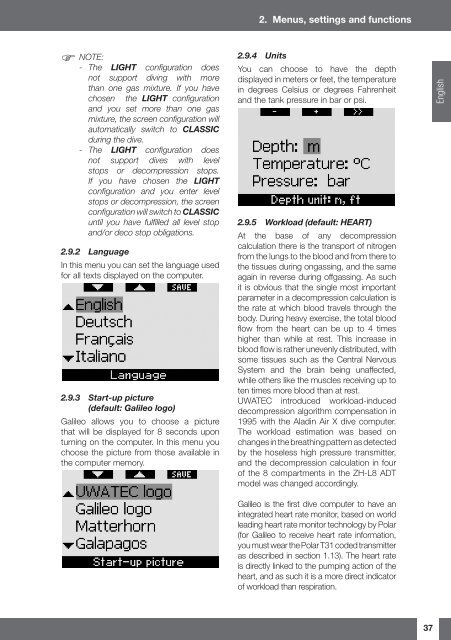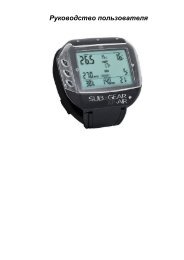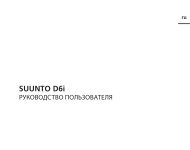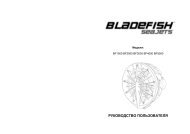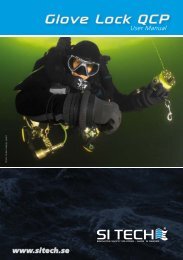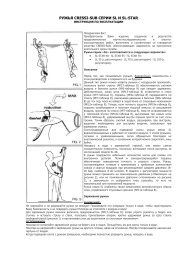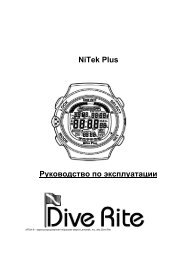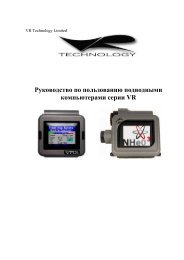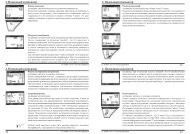Galileo SOL Manual - Scubapro
Galileo SOL Manual - Scubapro
Galileo SOL Manual - Scubapro
Create successful ePaper yourself
Turn your PDF publications into a flip-book with our unique Google optimized e-Paper software.
2. Menus, settings and functions<br />
NOTE:<br />
- The LIGHT confi guration does<br />
not support diving with more<br />
than one gas mixture. If you have<br />
chosen the LIGHT confi guration<br />
and you set more than one gas<br />
mixture, the screen confi guration will<br />
automatically switch to CLASSIC<br />
during the dive.<br />
- The LIGHT confi guration does<br />
not support dives with level<br />
stops or decompression stops.<br />
If you have chosen the LIGHT<br />
confi guration and you enter level<br />
stops or decompression, the screen<br />
confi guration will switch to CLASSIC<br />
until you have fulfi lled all level stop<br />
and/or deco stop obligations.<br />
2.9.2 Language<br />
In this menu you can set the language used<br />
for all texts displayed on the computer.<br />
2.9.3 Start-up picture<br />
(default: <strong>Galileo</strong> logo)<br />
<strong>Galileo</strong> allows you to choose a picture<br />
that will be displayed for 8 seconds upon<br />
turning on the computer. In this menu you<br />
choose the picture from those available in<br />
the computer memory.<br />
2.9.4 Units<br />
You can choose to have the depth<br />
displayed in meters or feet, the temperature<br />
in degrees Celsius or degrees Fahrenheit<br />
and the tank pressure in bar or psi.<br />
2.9.5 Workload (default: HEART)<br />
At the base of any decompression<br />
calculation there is the transport of nitrogen<br />
from the lungs to the blood and from there to<br />
the tissues during ongassing, and the same<br />
again in reverse during offgassing. As such<br />
it is obvious that the single most important<br />
parameter in a decompression calculation is<br />
the rate at which blood travels through the<br />
body. During heavy exercise, the total blood<br />
fl ow from the heart can be up to 4 times<br />
higher than while at rest. This increase in<br />
blood fl ow is rather unevenly distributed, with<br />
some tissues such as the Central Nervous<br />
System and the brain being unaffected,<br />
while others like the muscles receiving up to<br />
ten times more blood than at rest.<br />
UWATEC introduced workload-induced<br />
decompression algorithm compensation in<br />
1995 with the Aladin Air X dive computer.<br />
The workload estimation was based on<br />
changes in the breathing pattern as detected<br />
by the hoseless high pressure transmitter,<br />
and the decompression calculation in four<br />
of the 8 compartments in the ZH-L8 ADT<br />
model was changed accordingly.<br />
English<br />
<strong>Galileo</strong> is the fi rst dive computer to have an<br />
integrated heart rate monitor, based on world<br />
leading heart rate monitor technology by Polar<br />
(for <strong>Galileo</strong> to receive heart rate information,<br />
you must wear the Polar T31 coded transmitter<br />
as described in section 1.13). The heart rate<br />
is directly linked to the pumping action of the<br />
heart, and as such it is a more direct indicator<br />
of workload than respiration.<br />
37


